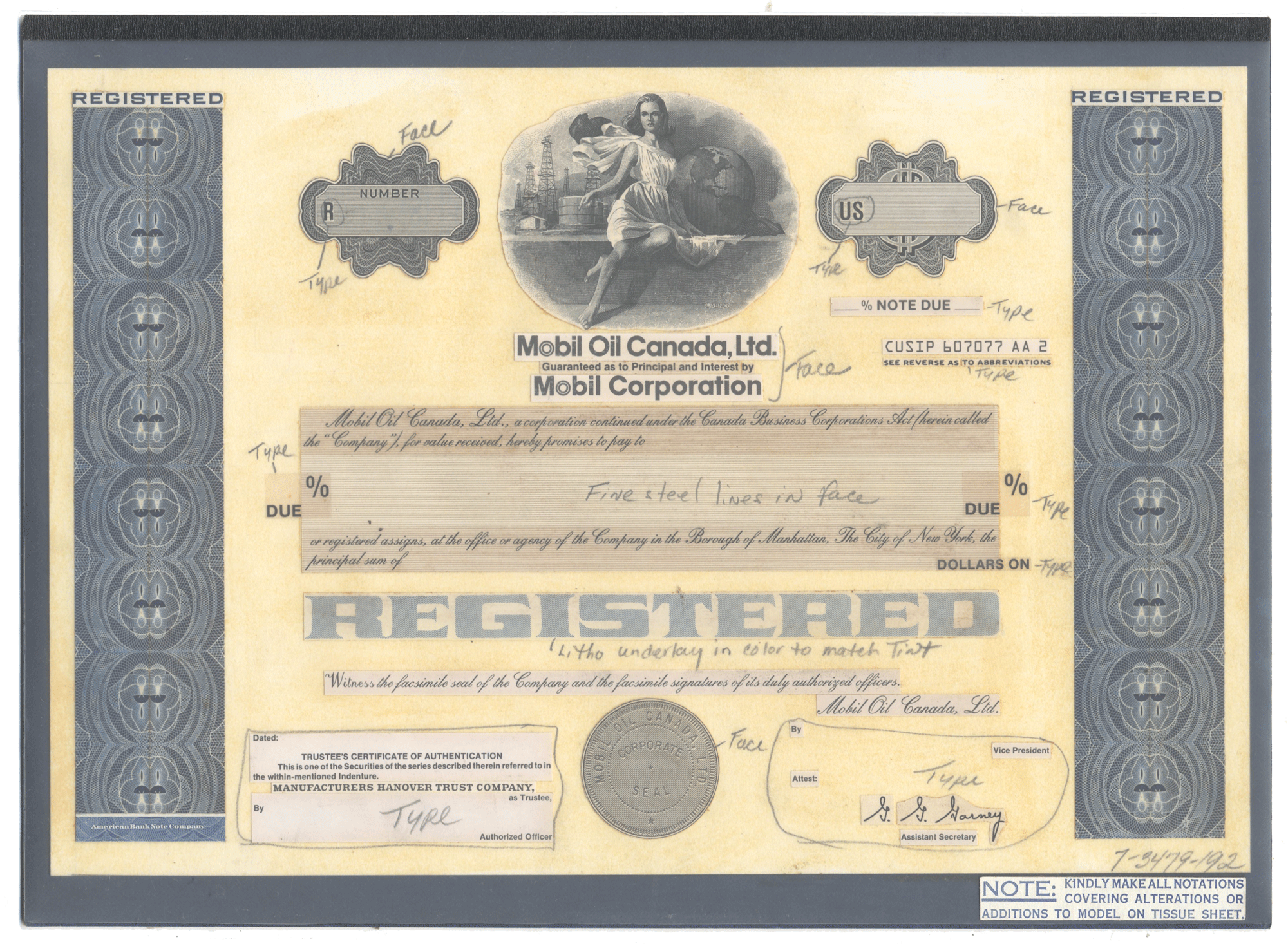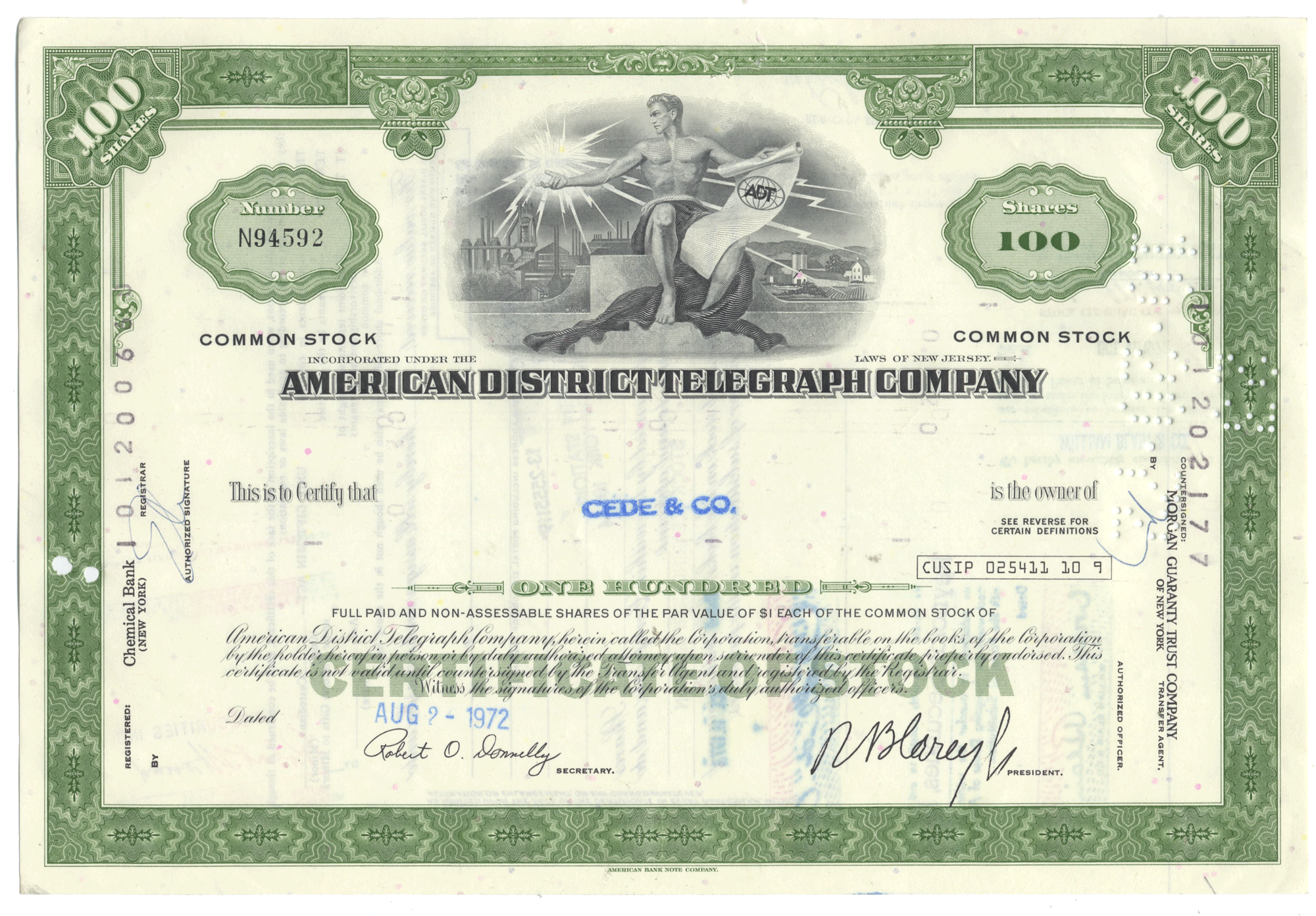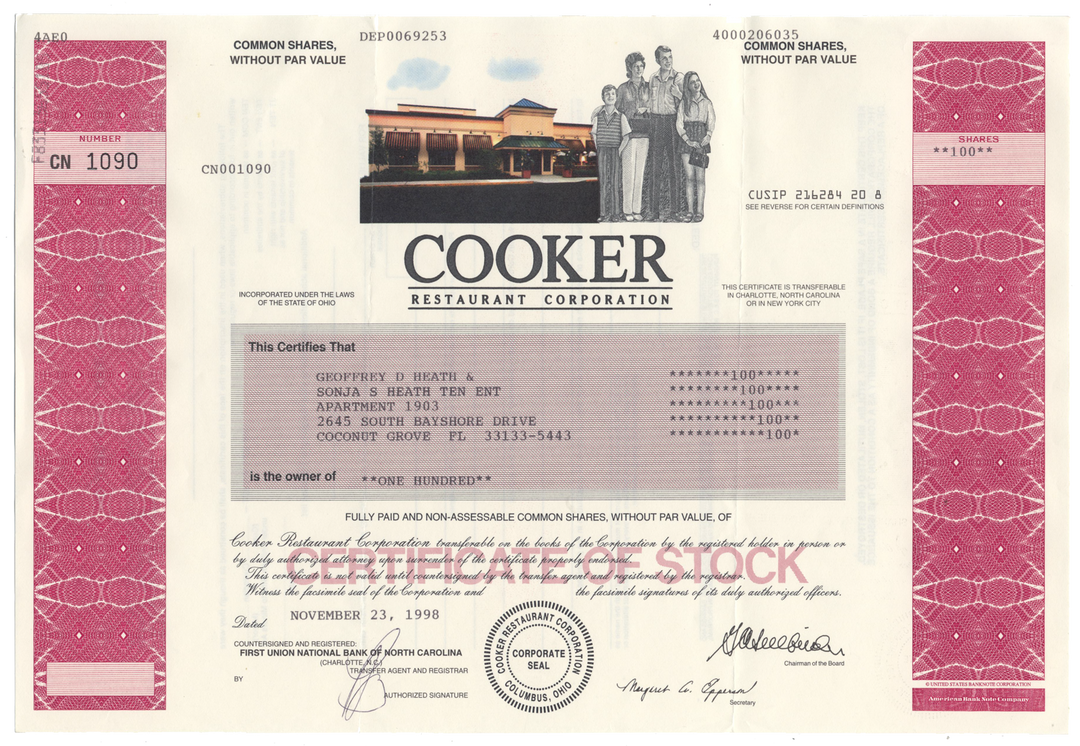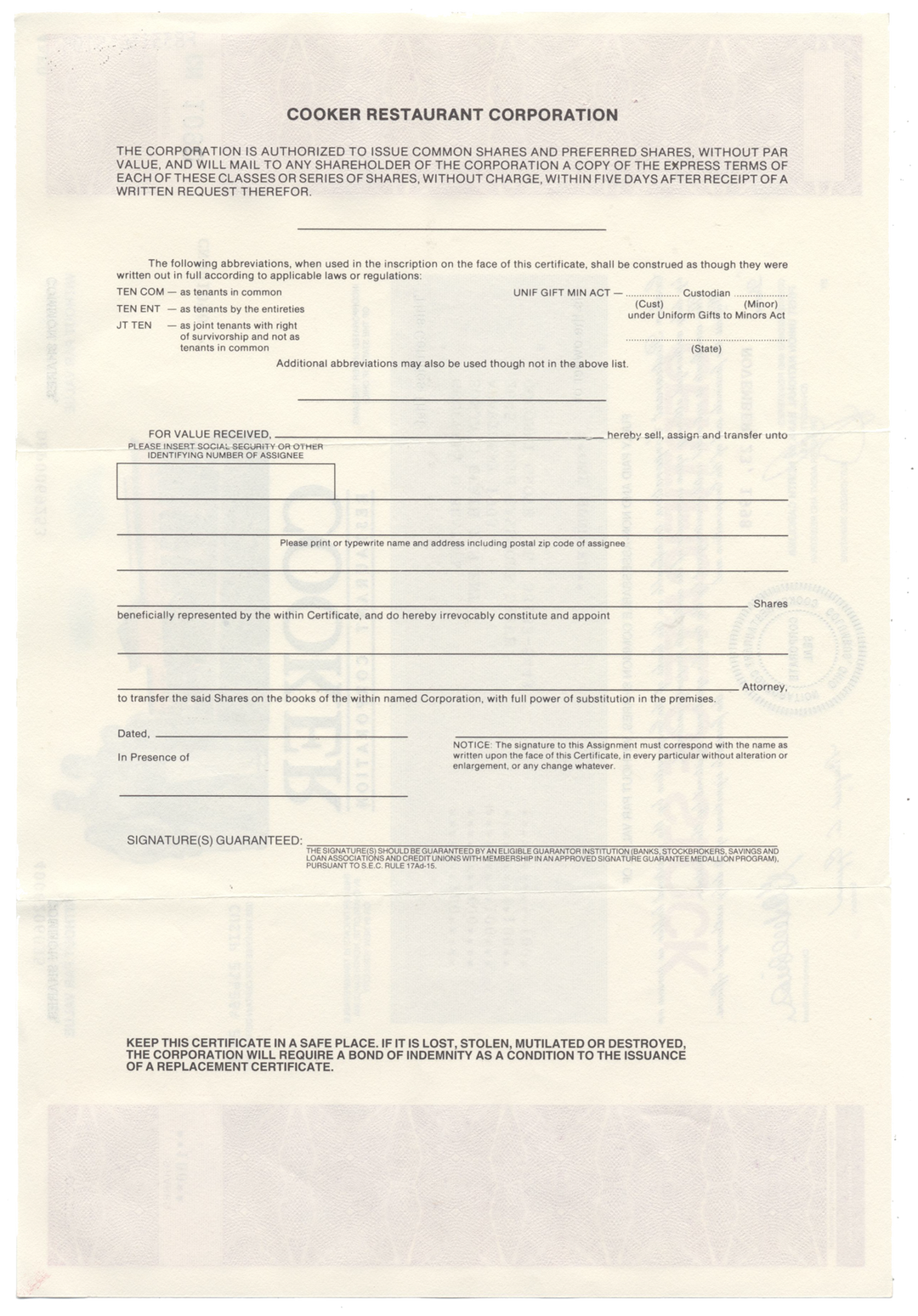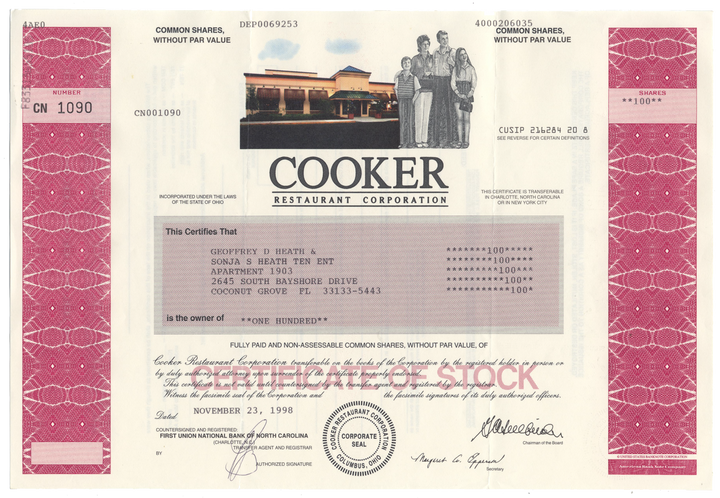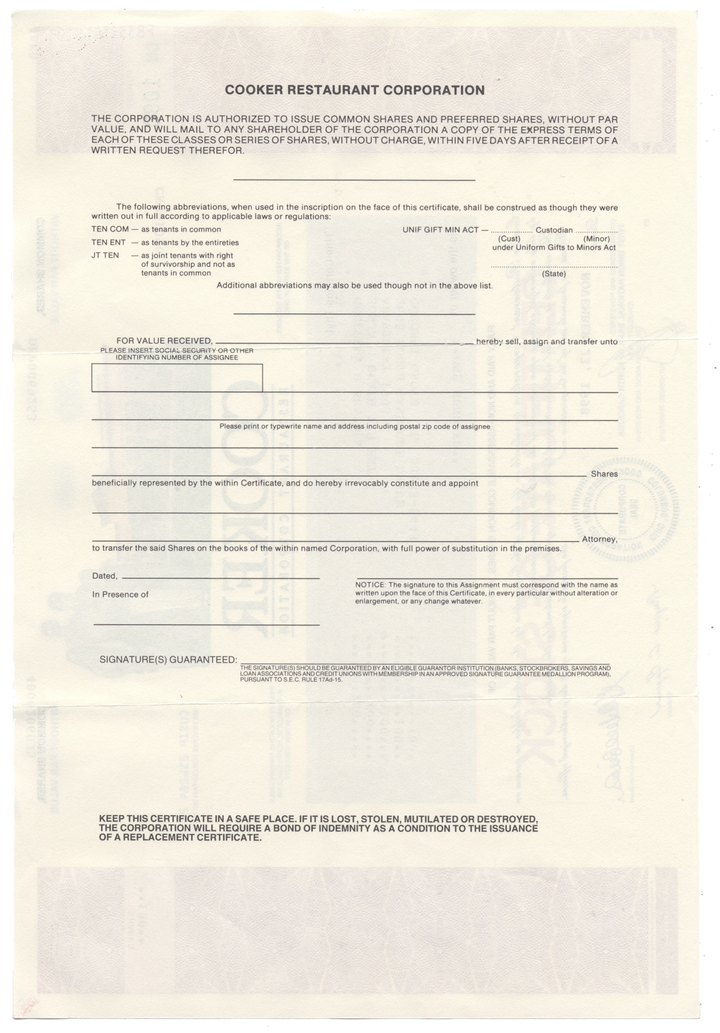Cooker Restaurant Corporation
- Guaranteed authentic document
- Orders over $50 ship FREE to U. S. addresses
Product Details
CompanyCooker Restaurant Corporation
Certificate Type
Common Stock
Date Issued
November 23, 1998
Canceled
No
Printer
American Bank Note Company
Signatures
Machine printed
Approximate Size
12" (w) by 8" (h)
Images
Show the exact certificate you will receive
Guaranteed Authentic
Yes
Additional Details
NA
Historical Context
In 1984, The Cooker Restaurant Corporation was founded in Nashville, Tennessee, by G. Arthur Seelbinder, a former Wendy's franchisee, along with three others - Phil Hickey, Jerry Hornbeck, and trained chef Glenn Cockburn. Cockburn, a graduate of the Culinary Institute of America, who became director and senior vice-president of operations for the company, created most of the items on the Cooker menu. Cockburn developed the home - style recipes that included pot roast, lasagna, soups, meatloaf, fish, steaks, sandwiches, hamburgers, ribs, and chicken--all made from scratch - for their restaurants. Cooker varied its menu with a wide assortment of salads and vegetables but originally set its sites on offering heartier fare with the intention of competing with the leaner menus served in trendier restaurants. They began by offering traditional dining at a moderate price, averaging $8.75 per meal, with items on the children's menu for $2.50.
In the early 1990's, in an effort to increase customer frequency, several value-priced items were added to the menu, including Caesar salad, grilled tuna Caesar salad, and an assortment of sandwiches. Obtaining a full liquor license resulted in boosted earnings that accounted for 14 percent of sales. Cooker's policy was to offer a money-back, satisfaction guarantee, or to give away free meals if customers were dissatisfied. In 1992, Cooker gave away $750,000 in free meals to back up the guarantee and justified that expense as a positive advertising strategy.
The company instituted an aggressive expansion plan, but struggled with stagnant sales and slim margins. Cockburn explained to Marjorie Coeyman of Restaurant Business that the company "started as a mom-and-pop kind of place. It was casual and homey, but it wasn't attracting the kind of clientele we wanted. It wasn't profitable enough." Pricing was too low, management thought, and its valued servers were leaving because their tips were based on checks averaging less than $9. The company instituted a more upscale menu and interior appearance. Explained Cockburn, "Low-voltage lighting replaced the warmer, pink lights of earlier units. Old-fashioned black-and-white photos aimed at evoking a cheerful, nostalgic tone gave way to starker art photos of, for instance, a lone tomato. Customers didn't like it. They looked at it and said, 'That looks too expensive.'" As a result Cooker got burned by going too upscale, which alienated former customers.
The company made changes in its 1994 development schedule following a 52 percent plunge in profits and targeted only six new sites for the year from its previous target of 12 stores. Cooker began a retraining effort for management and serving staff in an attempt to restore service standards and levels of ambiance which had faltered following cost cuts. "We've had to retool a bit," Glenn Cockburn told Bill Carlino of Nation's Restaurant News. He continued, "But we've had tough times before. You can say we've recommitted ourselves to the basics." The marketing team spent more than $100,000 on a radio and print campaign, deviating from the previous word-of-mouth promotional strategy, and introduced a new menu. Then, in November, Cooker began organizing a new management team beginning with the selection of General Mills's China Coast Division operations vice-president Philip L. Pritchard as the new company president, a newly created position.
Cooker continued its expansion efforts, concentrating efforts on selecting sites in close proximity to office and retail centers. The company's expansion plans also continued to involve the opening of new restaurants in regions where Cooker restaurants already existed. The new operational strategy soon paid off. In 1996, the company acquired six former China Coast Restaurants from Darden Restaurants, Inc. (owners of Olive Garden Italian Restaurants) with the intention of converting them to the Cooker concept in the areas of Saginaw and Grand Rapids, Michigan; Cincinnati, Ohio; Chesapeake, Virginia; and Tampa, Florida. Eleven new Cooker restaurants opened in 1996 - showing strong performance - and plans were implemented for the opening of another dozen or so by the end of fiscal 1997. According to an interview in Financial News with Nashville analyst Jonathan Ruykhaver, "Not only have they [Cooker] gotten preopening expenses and labor costs down, but they're continuing to improve unit volumes, and every extra sales dollar on top helps those margins."
Unfortunately, Cooker faced problems in the late 1990s and was once again forced to pare back its expansion efforts. While sales reached an all time high of $160.5 million in 1998, net income remained flat. Cooker's finances began to feel the pains of mounting debt, slowing sales growth, and falling customer traffic brought on by increased competition. In attempt to give its menu new life, Cooker added new items that included bruschetta, oriental chicken salad, and roasted portobello grill to its offerings. The company also decided to update its menu three times per year.
Hoping that some new blood would bolster Cooker's operations, the company named Henry Hillenmeyer chairman and CEO in August 1999. The new leader faced challenges, however, as the first years of the new century proved to be a financial challenge. Sales fell to $147 million in 2000 and then dropped to $112.9 million in 2001. Under his leadership, the firm began selling off its stores in the south. Company headquarters were then moved from Florida - an unprofitable region for Cooker - to Nashville, Tennessee. Store count fell from 66 in ten states in 2000 to 50 in five states by mid-2001. In May of that year, Cooker was forced to declare Chapter 11 bankruptcy.
Cooker emerged from bankruptcy the following year, and whittled locations down to 40. However, the company was never able to regain its footing. In April of 2004, Cooker - now down to 20 locations - shut down it's remaining restaurants and began liquidating its assets.
Related Collections
Additional Information
Certificates carry no value on any of today's financial indexes and no transfer of ownership is implied. All items offered are collectible in nature only. So, you can frame them, but you can't cash them in!
All of our pieces are original - we do not sell reproductions. If you ever find out that one of our pieces is not authentic, you may return it for a full refund of the purchase price and any associated shipping charges.


